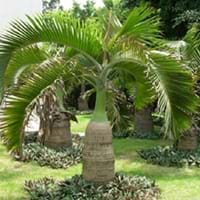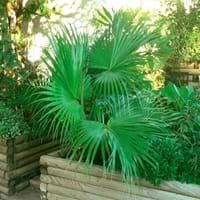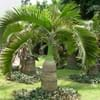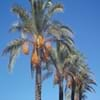Life Span
Perennial
Perennial
Type
Palm or Cycad
Palm or Cycad
Origin
Madagascar
United States, Southeastern United States, South-Central United States
Types
Not Available
Not Available
Number of Varieties
Not Available
Habitat
Hot climate regions, Humid climates, Loamy soils
Floodplains, Lowland, River side, Swamps
USDA Hardiness Zone
10-15
7-12
Sunset Zone
H1, H2, 24
H1, H2, 3b, 4, 5, 6, 7, 8, 9, 12, 13, 14, 15, 16, 17, 19, 21, 22, 23, 24
Habit
Arching/Fountain-shaped
Clump-Forming
Flower Color
White, Ivory
Ivory
Flower Color Modifier
Bicolor
Bicolor
Fruit Color
Black
Chocolate, Black
Leaf Color in Spring
Green
Green, Gray Green, Dark Green
Leaf Color in Summer
Green, Dark Green
Gray Green, Dark Green
Leaf Color in Fall
Green, Dark Green
Green, Gray Green, Dark Green
Leaf Color in Winter
Green, Dark Green
Olive, Gray Green, Dark Green
Leaf Shape
Acicular
Circular, dissected, long and linear
Plant Season
Spring, Summer, Fall, Winter
Spring, Summer, Fall, Winter
Sunlight
Full Sun, Partial Sun
Full Sun, Partial Sun, Partial shade
Growth Rate
Very Slow
Slow
Type of Soil
Loam, Sand
Clay, Loam, Sand
The pH of Soil
Acidic, Neutral, Alkaline
Acidic, Neutral, Alkaline
Soil Drainage
Well drained
Poorly Drained
Bloom Time
Early Summer, Summer
Early Summer
Tolerances
Drought
Wet Site, Salt
Where to Plant?
Ground
Container, Ground
How to Plant?
Seedlings, Transplanting
Seedlings, Stem Planting
Plant Maintenance
Medium
Medium
Watering Requirements
Average Water Needs, Needs a lot of water initially
Do Not over Water, Never Over-water, Requires regular watering, Requires watering in the growing season
In Summer
Lots of watering
Lots of watering
In Spring
Moderate
Moderate
In Winter
Average Water
Average Water
Soil pH
Acidic, Neutral, Alkaline
Acidic, Neutral, Alkaline
Soil Type
Loam, Sand
Clay, Loam, Sand
Soil Drainage Capacity
Well drained
Poorly Drained
Sun Exposure
Full Sun, Partial Sun
Full Sun, Partial Sun, Partial shade
Pruning
Prune ocassionally, Remove dead leaves, Remove old, faded fronds
Remove damaged leaves, Remove dead leaves
Fertilizers
Magnesium, Nitrogen, Potassium, slow-release fertilizers
fertilize every 2-3 weeks while growing
Pests and Diseases
Bark beetles, Moth, Ring Rot, Rust, Scale
Insects
Plant Tolerance
Heat Tolerance, Soil Compaction, Sun
Drought
Flowers
Insignificant
Insignificant
Flower Petal Number
Single
Single
Foliage Texture
Bold
Bold
Foliage Sheen
Matte
Matte
Attracts
Flies, Mites, Woodpeckers
Birds
Allergy
drowsiness, Vomiting
Avoid during Pregnancy
Aesthetic Uses
Decorating walls, Landscape Designing, Showy Purposes
Beautification, Landscape Designing, Showy Purposes
Beauty Benefits
Making cosmetics, Removes dandruff, Skin inflammation
Not Available
Environmental Uses
Air purification, Shadow Tree
Air purification, Food for insects, Prevent Soil Erosion
Medicinal Uses
Anemia, Chronic fatigue, Cyanide Poisoning, Digestion problems, Emmoiliant, Fights Depression, High cholestrol, Indigestion, Skin Disorders
Asthma, Baldness, Cold, Cough, Migraines, Sore throat
Part of Plant Used
Fruits, Leaves, Tree trunks
Whole plant
Other Uses
Basketary, Biomass for fuel, For making oil, Jelly, Sometimes used for making wine, Traditionally considered as lucky plant, Used as Ornamental plant
Decoration Purposes, Employed in herbal medicine, Showy Purposes, Used as Ornamental plant, Used for its medicinal properties
Used As Indoor Plant
No
Yes
Used As Outdoor Plant
Yes
Yes
Garden Design
Container, Feature Plant, Foundation, Houseplant, Mixed Border, Tropical
Bog Garden, Feature Plant, Foundation, Hedges, Mixed Border, Tropical
Botanical Name
HYOPHORBE lagenicaulis
SABAL minor
Common Name
Bottle Palm
Bush Palmetto, Dwarf Palmetto, Little Blue Stem, Swamp Palmetto
In Hindi
Palm
बौना पल्मेट्टो
In German
Palme
Zwerg Palmetto
In French
Paume
Palmetto nain
In Spanish
Palma
Palmetto enano
In Greek
Παλάμη
Νάνος Palmetto
In Portuguese
Palma
Palmetto anão
In Polish
Palma
Dwarf Palmetto
In Latin
Vero
Pumilio Palmetto
Phylum
Angiosperms
Magnoliophyta
Class
Liliopsida
Liliopsida
Family
Arecaceae
Arecaceae
Genus
Archontophoenix
Sabal
Clade
Angiosperms, Commelinids, Monocots
Angiosperms, Commelinids, Monocots
Tribe
Areceae
Not Available
Subfamily
Arecoideae
Coryphoideae
Importance of Bottle Palm and Dwarf Palmetto
Want to have the most appropriate plant for your garden? You might want to know the importance of Bottle Palm and Dwarf Palmetto. Basically, these two plants vary in many aspects. Compare Bottle Palm and Dwarf Palmetto as they differ in many characteristics such as their life, care, benefits, facts, etc. Every gardener must at least have the slightest clue about the plants he wants to plant in his garden. Compare their benefits, which differ in many ways like facts and uses. The medicinal use of Bottle Palm is Anemia, Chronic fatigue, Cyanide Poisoning, Digestion problems, Emmoiliant, Fights Depression, High cholestrol, Indigestion and Skin Disorders whereas of Dwarf Palmetto is Asthma, Baldness, Cold, Cough, Migraines and Sore throat. Bottle Palm has beauty benefits as follows: Making cosmetics, Removes dandruff and Skin inflammation while Dwarf Palmetto has beauty benefits as follows: Making cosmetics, Removes dandruff and Skin inflammation.
Compare Facts of Bottle Palm vs Dwarf Palmetto
How to choose the best garden plant for your garden depending upon its facts? Here garden plant comparison will help you to solve this query. Compare the facts of Bottle Palm vs Dwarf Palmetto and know which one to choose. As garden plants have benefits and other uses, allergy is also a major drawback of plants for some people. Allergic reactions of Bottle Palm are drowsiness and Vomiting whereas of Dwarf Palmetto have Avoid during Pregnancy respectively. Having a fruit bearing plant in your garden can be a plus point of your garden. Bottle Palm has showy fruits and Dwarf Palmetto has showy fruits. Also Bottle Palm is not flowering and Dwarf Palmetto is not flowering . You can compare Bottle Palm and Dwarf Palmetto facts and facts of other plants too.





